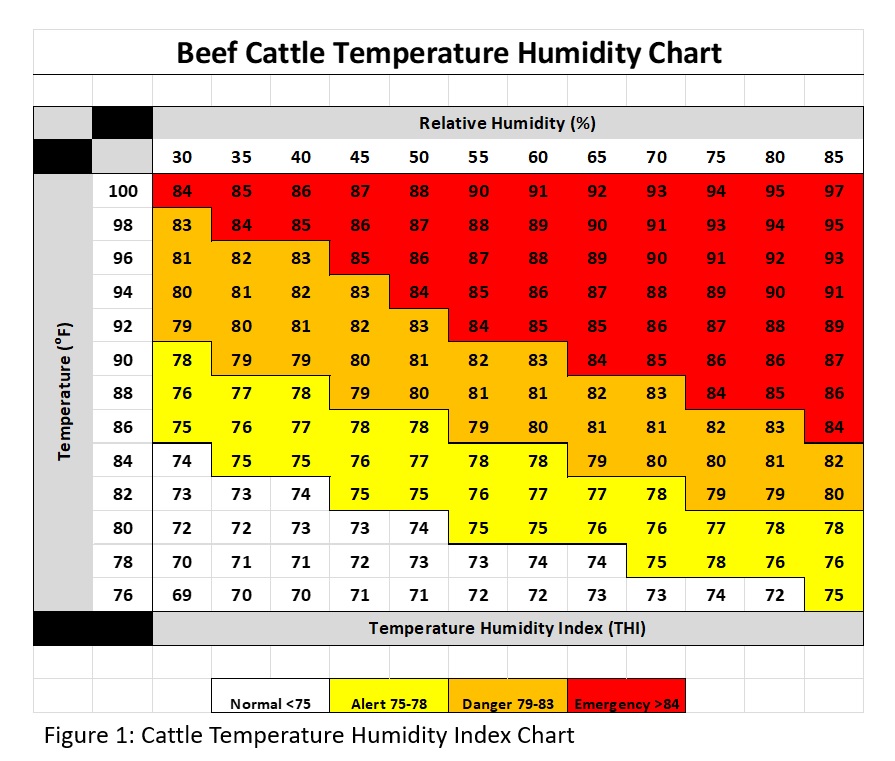Florida ranchers will need to guard their herd from cattle heat stress in order to protect their animals’ health and profits.
The Sunshine State could also be called The Heat State or The High Humidity State during the months of June, July, and August, but those names don’t have as nice a ring to them. The strong UV rays from the sun and the daily afternoon thunderstorms come together to create an environment that is tough to live in, and that goes for cattle too. Cattle heat stress isn’t just uncomfortable for the animals; it can also lead to a lower cattle body condition score, loss of production, and loss of profits. Florida cattle producers must protect their herds from heat stress, and the first step is understanding when their herd is most likely to experience it. See the details from a UF/IFAS blog below.
Cattle Heat Stress and Temperature Humidity Index (THI)
A UF/IFAS blog shared the following: “There are different levels of heat stress in cattle. These levels are based on the temperature humidity index (THI). The THI is calculated by the ambient air temperature and the relative humidity percentage.” The THI takes the temperature outdoors and the humidity and calculates a number—the index value—that indicates whether the combination of temperature and humidity is likely to create heat stress in cattle.
An index value of 79 or greater creates a dangerous combination for cattle; levels above 85 can be deadly. Cattle producers should start preventative measures if the index value is nearing 75. See the chart, from the University of Nebraska, below.

The UF/IFAS blog shares the example that an 88-degree day coupled with 65% humidity creates a THI value of 82, which is in the danger zone for creating cattle heat stress. (These numbers were from an actual day in Florida—May 23rd, 2023). Most summer days in Florida will get close to the danger zone, if not directly in it. Cattle producers must take steps to prevent heat stress in their herds to protect animal health and profits.
Preventing Cattle Heat Stress
The UF/IFAS blog shared the following tips to prevent heat stress in cattle:
- “Provide enough shade for the number of cattle on the pasture. It is recommended to have 40-60 square feet of shade per head of cattle available.”
- “Provide plenty of water, 2-3 gallons of water per 100 pounds of body weight per animal. Water should not be extremely hot. If pipes or hoses transporting the water to the trough are in the direct sun, the water will be hot. Precautions should be taken to cover or bury the pipes or hoses.”
- “For cattle in barns, fans and sprinklers can assist in reducing the temperature and increasing the air flow.”
- “Rotating or working cattle in the early morning or late evening will reduce the amount of stress they encounter.”
- “Provide free-choice minerals and salt so cattle can replenish the amount lost and meet their needs.”
- Feeding cattle in the early morning or late evening will increase their feed consumption, reducing the amount of weight that is lost.”
- “Flies and other external parasites should be controlled. When there are excessive flies and parasites around cattle they tend to bunch up, increasing temperatures.”
The blog also mentions to try incorporating “brahman genetics or select cattle that are adapted to Florida’s weather conditions. The skin pigment of brahman cattle is dark and protects against UV damage from solar radiation. Shorter hair coats allow the animals to sweat more efficiently, larger sweat glands allow the animals to sweat at a higher rate, and light-colored hair reflects radiative heat.”
See our next blog on recognizing heat stress in cattle.
Griffin Fertilizer is committed to helping both growers and ranchers make sound agronomic and economic decisions in order to maximize the health of their grove and pasture. As a full-service custom dry & liquid fertilizer blender and crop protection product distributor, we will continue our mission to further advance Florida agriculture. For questions -or concerns about your farm or pasture, contact us and one of our team will be in touch.